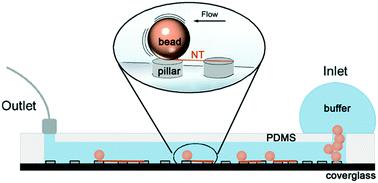Our official English website, www.x-mol.net, welcomes your
feedback! (Note: you will need to create a separate account there.)
Microfluidic chip with pillar arrays for controlled production and observation of lipid membrane nanotubes.
Lab on a Chip ( IF 6.1 ) Pub Date : 2020-06-29 , DOI: 10.1039/d0lc00451k Juan Manuel Martinez Galvez 1 , Maite Garcia-Hernando , Fernando Benito-Lopez , Lourdes Basabe-Desmonts , Anna V Shnyrova
Lab on a Chip ( IF 6.1 ) Pub Date : 2020-06-29 , DOI: 10.1039/d0lc00451k Juan Manuel Martinez Galvez 1 , Maite Garcia-Hernando , Fernando Benito-Lopez , Lourdes Basabe-Desmonts , Anna V Shnyrova
Affiliation

|
Lipid membrane nanotubes (NTs) are a widespread template for in vitro studies of cellular processes happening at high membrane curvature. Traditionally NTs are manufactured one by one, using sophisticated membrane micromanipulations, while simplified methods for controlled batch production of NTs are in growing demand. Here we propose a lab-on-a-chip (LOC) approach to the simultaneous formation of multiple NTs with length and radius controlled by the chip design. The NTs form upon rolling silica microbeads covered by lipid lamellas over the pillars of a polymer micropillar array. The array's design and surface chemistry set the geometry of the resulting free-standing NTs. The integration of the array inside a microfluidic chamber further enables fast and turbulence-free addition of components, such as proteins, to multiple preformed NTs. This LOC approach to NT production is compatible with the use of high power objectives of a fluorescence microscope, making real-time quantification of the different modes of the protein activity in a single experiment possible.
中文翻译:

具有柱阵列的微流控芯片,可控制脂质膜纳米管的生产和观察。
脂质膜纳米管(NTs)是体外广泛使用的模板研究在高膜曲率下发生的细胞过程。传统上,NTs是使用复杂的膜微操作逐一制造的,而对NTs的受控批量生产的简化方法的需求日益增长。在这里,我们提出了一种芯片上实验室(LOC)方法来同时形成多个NT,这些NT的长度和半径由芯片设计控制。NTs在聚合物微柱阵列的柱子上滚动被脂质薄片覆盖的二氧化硅微珠时形成。阵列的设计和表面化学性质决定了所得独立式NT的几何形状。阵列在微流体腔室内的集成进一步使得能够将组分(例如蛋白质)快速且无湍流地添加到多个预先形成的NT中。
更新日期:2020-07-29
中文翻译:

具有柱阵列的微流控芯片,可控制脂质膜纳米管的生产和观察。
脂质膜纳米管(NTs)是体外广泛使用的模板研究在高膜曲率下发生的细胞过程。传统上,NTs是使用复杂的膜微操作逐一制造的,而对NTs的受控批量生产的简化方法的需求日益增长。在这里,我们提出了一种芯片上实验室(LOC)方法来同时形成多个NT,这些NT的长度和半径由芯片设计控制。NTs在聚合物微柱阵列的柱子上滚动被脂质薄片覆盖的二氧化硅微珠时形成。阵列的设计和表面化学性质决定了所得独立式NT的几何形状。阵列在微流体腔室内的集成进一步使得能够将组分(例如蛋白质)快速且无湍流地添加到多个预先形成的NT中。











































 京公网安备 11010802027423号
京公网安备 11010802027423号